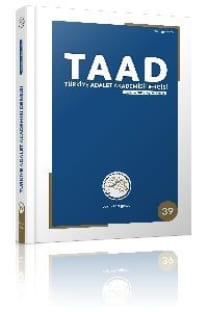HUKUKİ REALİZM PERSPEKTİFİNDEN HUKUK ÖĞRETİMİNİN SORUNSALLAŞTIRILMASI
Çağın ihtiyaçları ve iktidar pratikleri hukukun düzen fonksiyonunun diğer fonksiyonlarına nispetle öne çıkmasına neden olmuştur. Bu durum norm-değer, norm-olgu ilişkilerinin geri plana itilerek salt norm-düzen ilişkisinin kuramda ve uygulamada vurgulanması sonucunu doğurmaktadır. Hukuk düzene indirgenmiş bulunmaktadır. Düzen talebi hukuku sözüne güvenilir kılma girişimlerini hızlandırmış ve bunun neticesinde hukuk da sözden ibaret görünmeye başlamıştır. Bu kabul, hukuk öğretimini de etkilemiştir. Hukuk fakülteleri bir ülkenin en yetenekli gençlerini kabul etmektedirler. Ancak bu öğrenciler, günümüzde sözün ötesinde olanı görmelerini, göstergelerin işaret ettiği olguları keşfedebilmelerini ve değer duyarlılığı gösterebilmelerini engelleyen bir sersemletme sürecinden başarıyla geçebildikleri takdirde diploma sahibi olmaktadırlar. Hukuki realizm akımı, değer konusundaki eksikliklerini bir yana bırakırsak, norm-olgu ilişkisine atıfla bir eleştiri ortaya koyar. Hukuk öğretiminin hukukun olgusallığına uygun bir çok boyutluluğu haiz olmasını talep eder. Bu talepler, hukuk öğretiminin yavanlığının ve kifayetsizliğinin izalesi yolunda kılavuzluk edebilirler
Anahtar Kelimeler:
Hukuk Öğretimi, Hukuki Realizm, Hukuk Kliniği
The Problematization of Legal Education from the Perspective of Legal Realism
The needs of our age and the practices of power caused a process within which the order function of norm became prominent in comparison with the other functions. This situation caused norm-value and norm-fact relations to retreat into background in the theory and practice of law. Law is reduced to order. Demand of order intensified the efforts bound for a law which is certain and faithful to its words. Consequently, we start to confer law as a body which consists of words. This conclusion also effected the legal education. Law faculties accept only the most qualified youngsters of a country. And today, to become a lawyer, these youngsters have to complete a stupefying education process which destroys their ability to see beyond the words, their curiosity to discover the facts behind the signs, and their awareness about the values immanent to law. Legal realism, apart from its apathy of values, by referring to normfact relations provides a competent criticism. It demands a legal education which has the multidimensionality which suits the factivity of the law. These demands, could lead the way of removing the platitude of legal education
Keywords:
Legal Education, Legal Realism, Legal Clinics,
___
- Akman Şefik Taylan, “Hukuk Politika İlişkisi Bağlamında Eleştirel Hukuk Çalışmaları Hareketi”, Ankara Üniversitesi Hukuk Fakültesi Dergisi, c. 61, sy. 4, , ss. 1271-1306.
- Arat Tuğrul, Amerikan Hukuk Öğretiminde “Case Method”¸ Ankara Üniversitesi Hukuk Fakültesi Yayınları, Ankara 1968.
- Chase Anthony, “The Birth of the Modern Law School”, The American Journal of Legal History¸ c. 23, sy. 4, Ekim 1979, ss. 329-348, s. 334.
- Frank Jerome, “What Constitutes a Good Legal Education?”, American Bar Association Journal, c. 19, sy. 12, 1933.
- Frank Jerome, “Why Not A Clinical Lawyer-School?”, University of Pennsylvania Law Review, c. 81, sy. 8, 1932.
- Gürkan Ülker, Hukuki Realizm Akımı, Sevinç Matbaası, Ankara 1967.
- Holmes Eric Mills, “Education for Competent Lawyering –Case Method in a Functional Context”, Columbia Law Review, c. 76, sy. 4, Mayıs 1976, ss. 535- , s. 543-544.
- Klare Karl E., “The Law-School Curriculum in the 1980’s: What is Left?”, Journal of Legal Education, sy. 32, 1982, ss. 336-344, s. 337.
- Kennedy Duncan, “Legal Education and the Reproduction of Hierarchy”, Journal of Legal Education, c. 32, sy. 4, Aralık 1982, ss. 591-615.
- Kenny Courtney, “The Case-Method of Teaching Law”, Journal of the Society of Comparative Legislation, c. 16, sy. 2, 1916, ss. 182-194.
- Kılıç Muharrem, “Hukuk Öğreniminin Epistemolojik Temellendirimine Dair Dibace –Teknokrasiden Filozofiye-”, Akdeniz Üniversitesi Hukuk Fakültesi Dergisi, Antalya 2011.
- Llewellyn Karl, “Some Realism About Realism- To Responding Dean Pound,” Harvard Law Review, 1930-1931, vol. 44.
- Moskovitz Myron, “Beyond the Case Method: It’s Time to Teach with Problems”, Journal of Legal Education, sy. 42, 1992, ss. 241-271, s. 242.
- Patterson Dennis, “Langdell’s Legacy”, Northwestern University Law Review, c. 90. sy. 1, 1995, ss. 196-203.
- Topçuoğlu Hamide, Hukuk Sosyolojisi, Ankara Üniversitesi Hukuk Fakültesi Yayınları, 3. Baskı, İstanbul 1969.
- Tushnet Mark, “Critical Legal Studies: An Introduction to its Origins and Underpinnings”, Journal of Legal Education, c. 36, sy. 4, Aralık 1986, ss. 505
- Unger Roberta Mangabeira, “The Critical Legal Studies Movement,” Harvard Law Review, 1983, vol. 96, 561-675.
- Wacks Raymond, Hukuk Kuramını Anlamak, (çev. Fatma S. Şahin Ünver - Serdar Ünver), Astana Yayınları, Ankara 2016.
- Waters Lindsay, Akademinin Düşmanları, (çev. Müge Özbek), Boğaziçi Üniversitesi Yayınevi, İstanbul 2009.
- Wizner Stephen, “The Law School Clinic: Legal Education in the Interests of Justice”, Fordham Law Review, sy. 70, 2001, ss. 1929-1939, s. 1931.
- Yörükoğlu Ömer, Yirminci Yüzyılın İlk Yarısında Amerika Birleşik Devletlerinde Hakim Olan Hukuk Teorisi, İstanbul Üniversitesi Hukuk Fakültesi Yayınları, İstanbul 1982.
- ISSN: 1309-6826
- Başlangıç: 2010
- Yayıncı: Türkiye Adalet Akademisi
Sayıdaki Diğer Makaleler
ULUSLARARASI HUKUKTA YABANCI DEVLET BAŞKANLARININ HAYSİYETİNİN KORUNMASI
6769 SAYILI SINAÎ MÜLKİYET KANUNU İLE TÜRK TASARIM HUKUKUNDA YENİ DÖNEM
TİCARİ SIRLARIN VE KİŞİSEL VERİLERİN KORUNMASI KAPSAMINDA VERGİ MAHREMİYETİ
ULUSLARARASI HUKUKTA SİVİL VE DEVLET HAVA ARACI AYRIMI
AB TEMEL HAKLARININ ÜYE DEVLETLER ARASINDA KORUNMASI
HUKUKİ REALİZM PERSPEKTİFİNDEN HUKUK ÖĞRETİMİNİN SORUNSALLAŞTIRILMASI
AVRUPA OMBUDSMANI VE TÜRKİYE KAMU DENETÇİLİĞİ KURUMU: MUKAYESELİ BİR İNCELEME
